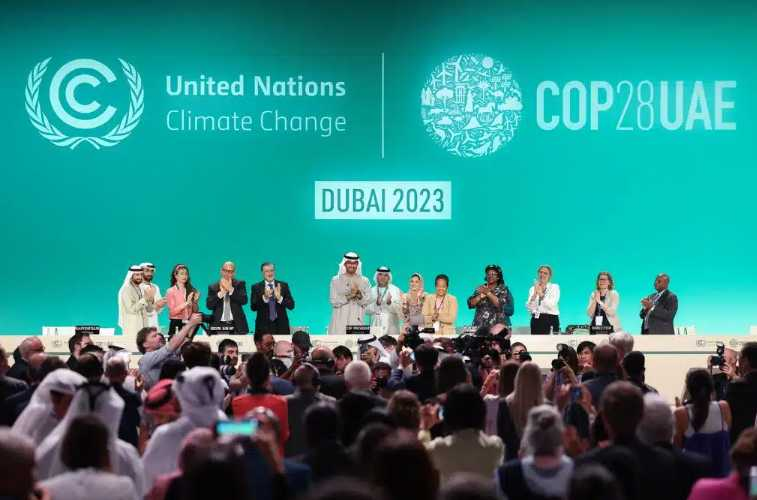Before you read this, keep in mind the use of Problem-Reaction-Solution, by THE POWERS THAT BE, to get people to approve what THEY plan... ~D
The race to reduce carbon emissions and achieve the goals of the 2015 Paris Agreement is intensifying, with many nations moving towards zero-carbon solutions. Despite this, current emission reduction efforts are falling short of international ambitions and it is clear that a different way of operating is needed. Hania Othman, Director of Sustainable Impact Europe/Africa at The HBAR Foundation, says a key to this could be distributed ledger technology.
Context
In 2021, the European Union (EU) embarked on an ambitious journey to reduce its greenhouse gas (GHG) emissions by at least 55% below the 1990 levels by 2030. This initiative is part of a broader strategy to position Europe as the world’s first climate-neutral continent by 2050, signalling a significant commitment to environmental sustainability.
Now, two years later, policymakers are eager to apply similar ambitions to the global climate agenda.
The COP28 conference, which took place late last year in Dubai, marked a crucial point in initiating this global dialogue, encouraging countries across the sphere to reduce their carbon emissions and accelerate efforts to achieve carbon neutrality on a global scale. An important outcome of the conference was a collective agreement among nations to “transition away” from fossil fuels. This marked a pivotal shift towards the end of the fossil fuel era and was a key component of the Global Stocktake, a comprehensive assessment under the 2015 Paris Agreement aimed at keeping the global temperature rise below 1.5C. The stocktake highlighted the need for significant reductions in GHG emissions and substantial increases in renewable energy capacity and energy efficiency improvements by 2030.

COP28 President Sultan Al Jaber and other participants onstage during the COP28 Closing Plenary at COP28 in Dubai on December 13, 2023. Photo: UNclimatechange/Flickr
The COP28 deal urges over 200 global economies to increase their efforts in a “just, orderly, and equitable manner,” triple renewable energy, and double the global average of energy efficiency by 2050. The agreement gives significant momentum to the transition away from fossil fuels, including a focus on reducing methane emissions and phasing out inefficient fossil fuel subsidies. The urgency of these targets is underscored by the need to limit global warming to 1.5C above pre-industrial levels, a threshold considered relatively safe by climate experts. However, the proposal is not without its flaws; developing countries have voiced their disappointment over the lack of new financial commitments to assist them in transitioning away from fossil fuels and adapting to climate impacts.
Another key concern that emerged at COP28 was whether we can achieve fair implementation of both the EU and COP28 directives, particularly in a way that does not disproportionately burden developing countries.
In the 27-nation bloc, the Corporate Sustainability Reporting Directive (CSRD) is instrumental in complementing global efforts. CSRD enhances the transparency of sustainability reporting among companies, aligning corporate practices with broader sustainability goals. Beyond being a mere disclosure regulation, CSRD offers a framework for businesses to adapt to an increasingly urgent low-carbon transition. On the other hand, the Carbon Border Adjustment Mechanism (CBAM) is designed to prevent carbon leakage by imposing a carbon price on imports of certain goods from outside the EU. This ensures that the EU’s ambitious climate efforts are not undermined by the relocation of carbon-intensive production to countries with less stringent climate policies. To create a fair playing field for both the EU and other global countries to achieve this unified goal, policymakers and other influential figures need to ensure that measures like CBAM do not lead to trade disputes or are perceived as protectionist by non-EU countries.
Upon delving deeper into the outlined goals, further shortcomings emerge. Firstly, the EU self-imposed targets inadvertently highlight its own difficulties in cutting down on carbon emissions. In fact, to reach the 2030 emissions goal, the bloc would need to make further cuts of 132 megatonnes of carbon dioxide a year, the equivalent of the annual output of 332 gas-powered stations.
With regard to the COP28 proposal, the antithetical “incremental” targets proposed have also raised doubts as to whether current carbon reduction strategies are pragmatic enough to achieve a meaningful environmental impact.
Dire Consequences
One needn’t look very far to identify the impact and the consequences of inaction. The world was repeatedly haunted by the images of abnormal fires ravaging forests, towns, and tourist spots across Greece in 2023. At the same time, last year was the UK’s second-hottest year on record, Ireland experienced its wettest-ever July, while parts of Bulgaria and Turkey were inundated with floods. The message is and has been clear for some time: climate change presents a grave threat to the planet and the consequences are becoming increasingly dire.
In the face of this, the EU has put mechanisms in place to enforce compliance with its climate goals, including penalties for non-compliance, albeit with lackluster enforcement. However, more action is clearly needed. Now more than ever, there is an impetus for world leaders to embrace emerging technologies such as blockchain and distributed ledger technologies to accelerate progress toward a low-carbon economy.
How Can Web3 Play a Part?
While there isn’t a “one-size fits all” solution that can be adapted to tackle the global climate crisis, the scale of the problem calls for a multifaceted approach. For instance, climate reporting is a complex task, hindered by issues such as the lack of detailed data, inconsistent methodologies often reliant on estimations, exclusive supply chain information, and general non-transparency.
Distributed ledger technology (DLT) can offer solutions to these challenges. The use of tokenization, in conjunction with integrated data Measurement, Reporting, and Verification (dMRV), offers a promising method to establish a public ledger for emission data. This approach can ensure uniformity in technical frameworks and utilize the inherent features of distributed ledgers – such as auditability, discoverability, and liquidity in emission offsetting and sustainability reporting scenarios. Additionally, the current system struggles with adequately verifying diverse attributes, which ultimately affects the effective accountability of both polluters and governmental entities.
Using tools such as the Guardian Policy Workflow Engine, an open-source dMRV tool that employs a standards-based approach for token taxonomies, we can trace sustainability outcomes more accurately and effectively. This advanced approach allows for the monitoring of impact down to the individual data attribute associated with the environmental and social impact. Consequently, it facilitates the creation of tailored solutions that are more accurately aligned with the unique characteristics and needs of each organization. This is an example of how, by leveraging DLT, governments, companies, and individuals can record and verify emissions data in an open and immutable manner. This enables stakeholders to have a clear understanding of their environmental, social, and governance impact and take necessary actions to reduce emissions and improve impact outcomes.
Real-World Impact
DLT can also play a crucial role in verifying carbon credit schemes, a carbon-mitigation process that has been the subject of contention since its initial rollout.
The credibility of these schemes depends on accurate measurement and verification of the emissions reductions, which at present, are not guaranteed. It is generally agreed that the credit schemes have ample room for improvement to deliver on set outcomes – with an investigation by the Guardian stating that over 90% of credits being bought do not represent genuine carbon reductions. As one might expect, this development has sent ripples of disruption throughout the industry. In a market that is still developing, such events significantly strain the fabric of trust and credibility. It is therefore important that we work to enhance the industry’s reputation, as it plays a crucial role in a broader portfolio of solutions essential for effective climate change mitigation. And given the less-than-favourable reputation associated with this industry, it makes sense to adopt fresh measures.
DLT can provide a tamper-proof and auditable system to ensure the integrity of carbon credit transactions, promoting trust and confidence in the market.
The technology can also be used to address industries that generate significant carbon emissions, such as the supply chain sector. By its nature, getting goods around the world is an energy- and fuel-intensive process, and there are notable inefficiencies within the supply chain industry that can be addressed using DLT. For instance, the technology can be used by supply chain participants to track and trace their products’ entire lifecycle, identifying inefficiencies and areas for improvement. This transparency enables companies to optimize processes, reduce emissions, and promote sustainability across the supply chain.
DLT-based platforms are also enabling the tokenization of carbon offsets, making it more accessible for individuals and organizations to participate in emission reduction projects.
Setting the Standard
The urgency to meet global carbon emission reduction targets cannot be overstated. It is important to address this issue, as it involves more than just legal and financial aspects; the implications for our planet’s future are dire. While global alliances have made good progress in reducing carbon emissions, we have a long way to go before we can alleviate the crisis that now presents itself. It’s time to find new ways of working.
By leveraging the innovative power of novel technologies such as DLT and open-source digital, measurement and reporting tools (dMRV), governments, companies, and individuals can enhance the transparency of their climate reporting, verify and trace (often opaque) carbon credit schemes, and reduce supply chain inefficiencies – and this is just the beginning. Web3 technology will be key to allowing global nations to really deliver on their commitments, and contribute to the ‘enhanced transparency framework’ currently being laid out. Perhaps most importantly, Web3 will enable us to shift global proposals from talk to action and embrace the transition to a sustainable future.





























